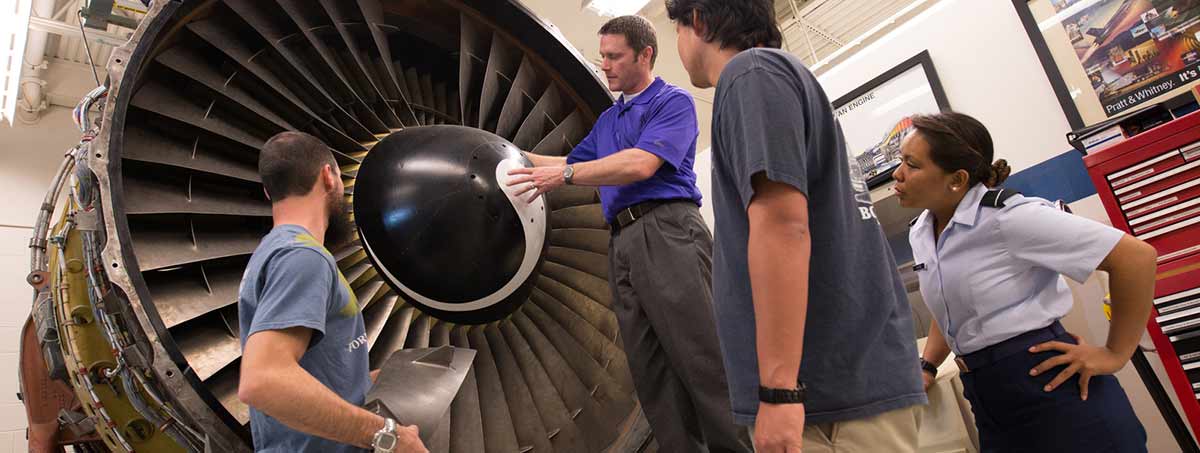The Aerospace Engineering department is the largest of its kind in the country, with 2,145 Bachelor of Science students, 111 Master of Science students and 68 Ph.D. students as of Fall 2023. Of our undergraduate students, 9.5% are honors students compared to 4.5% for the rest of the university. The undergraduate program had been ranked No. 1 by "U.S. News and World Report" from 2000-2015 when the Daytona campus was classified among non-Ph.D.-granting institutions. Since being reclassified into the Ph.D.-granting category in 2016, it has been ranked in the top 10 the last five years. Currently, our program ranks No. 4 in the country, above some elite Aerospace Engineering programs, and No. 1 in the state of Florida. Our graduate program started being ranked only in 2016 and is currently ranked 25th in the nation and No. 2 in the state of Florida. Our department is striving for diversity, equity and inclusion of all students. Currently, we have 23% female students and 24% underrepresented minorities in our B.S. program, which is about 7% and 9% (respectively) higher than the national average for Aerospace Engineering programs.
Aerospace Engineering deals with the scientific principles that govern the design of airplanes, spacecraft, and jet engines. After studying fundamental mathematics and physics, Aerospace Engineering students study the core areas of aerodynamics and propulsion, dynamics and control, and structures and materials. These studies give them the necessary background to take the year-long senior capstone aircraft/spacecraft/propulsion design courses. There are ample opportunities for lab courses and hands-on experiences.
Visit the website of the Department of Aerospace Engineering
Submissions from 2025
Power to Liquid and Hydrogen Use for Saf Production; A Policy and Techno-Economic Overview for Aviation, Eva Maleviti
Submissions from 2024
Immersive Framework for Designing Trajectories Using Augmented Reality, Joseph Anderson, Leo Materne, Karis Cooks, Michelle Aros, Jaia Huggins, Jesika Geliga-Torres, Kamden Kuykendall, David Canales, and Barbara Chaparro
Submissions from 2023
Dual Quaternion Relative Dynamics for Gravity Recovery Missions, Ryan Kinzie, Riccardo Bevilacqua, and Seo Dongeun
Using Machine Learning to Predict Hypervelocity Fragment Propagation of Space Debris Collisions, Katharine Larsen and Riccardo Bevilacqua
Predicting Dynamic Fragmentation Characteristics from High-Impact Energy Events Utilizing Terrestrial Static Arena Test Data and Machine Learning, Katharine Larsen, Riccardo Bevilacqua, Omkar S. Mulekar, Elisabetta L. Jerome, and Thomas J. Hatch-Aguilar
State Space Modeling and Estimation of Flexible Structure Using the Theory of Functional Connections, Carlo Lombardi and Riccardo Bevilacqua
Feedback Control Methods on Short-Period Orbits Of the Earth-Moon Equilateral Libration Points, Luis E. Mendoza Zambrano, Franco Criscola, David Canales Garcia, Riccardo Bevilacqua, Stephen Eikenberry, Octavi Fors, José María Gómez, and Andrea Richichi
Solar Sailing Adaptive Control Using Integral Concurrent Learning for Solar Flux Estimation, Luis Enrique Mendoza Zambrano and Riccardo Bevilacqua
Six-degree-of-freedom Optimal Feedback Control of Pinpoint Landing using Deep Neural Networks, Omkar S. Mulekar, Hancheol Cho, and Riccardo Bevilacqua
Stability of Deep Neural Networks for Feedback-Optimal Pinpoint Landings, Omkar S. Mulekar, Hancheol Cho, and Riccardo Bevilacqua
Stereoscopic-Based Mass Properties Estimation for Warhead Fragments, Alessia Nocerino, Katharine Larsen, Riccardo Bevilacqua, and Elisabetta L. Jerome
Experimental validation of inertia parameters and attitude estimation of uncooperative space targets using solid state LIDAR, Alessia Nocerino, Roberto Opromolla, Giancarmine Fasano, Michele Grassi, Spencer John, Hancheol Cho, and Riccardo Bevilacqua
Submissions from 2022
The Effect of Pre-Thermal and -Load Conditions on IN-718 High Temperature Fatigue Life, Paulina De La Torre and Alberto Mello
Preliminary Study of Shape-Memory Alloy Torsional Tubes as Thermal Management Actuators Under Non-ideal Conditions, Paula Sanjuan Espejo, Samuel Desloover, Devon Hardy, Mark Ricklick, Frederick Calkin, and David Foutch
Experimental Study of Wall Bounded Harbor Seal Whisker Inspired Pin Geometries, Anish Prasad and Mark Ricklick
Influence of Cold Expansion and Aggressive Environment on Crack Growth in AA2024-T3, Ken Shishino, Christopher Leirer, and Alberto Mello
Submissions from 2018
Mechanical and Electrical Characterization of Carbon Fiber/Bucky Paper/Zinc Oxide Hybrid Composites, Suma Ayyagari, Marwan Al-Haik, and Virginie Rollin
Floating Active Baffles, System and Method of Slosh Damping Comprising the Same, Dae Won Kim, Rudy L. Baum, Vijay Santhanam, Balaji Sivasubramanian, and Sathya Gangadharan
Submissions from 2016
Heating Element Including Carbon Nanotube (CNT) Layer, Santhosh Kumar Loganathan, Virginie Rollin, and Daewon Kim
Submissions from 2012
Strain Rate and Orientation Dependencies of the Strength of Single Crystalline Copper under Compression, Virginie Dupont and Timothy C. Germann
Submissions from 2011
Use of the Richtmyer-Meshkov Instability to Infer Yield Stress at High-Energy Densities, Guy Dimonte, G. Terrones, F. J. Cherne, T. C. Germann, Virginie Dupont, K. Kadau, W. T. Buttler, D. M. Oro, C. Morris, and D. L. Preston
Submissions from 2010
Nanoindentation and Plasticity in Nanocrystalline NI Nanowires: A Case Study in Size Effect Mitigation, F. Sansoz and Virginie Rollin
Submissions from 2009
Molecular Dynamics Study of Crystal Plasticity during Nanoindentation in Ni Nanowires, V. Dupont and F. Sansoz
Submissions from 2006
Grain Growth Behavior at Absolute Zero during Nanocrystalline Metal Indentation, F. Sansoz and V. Dupont

